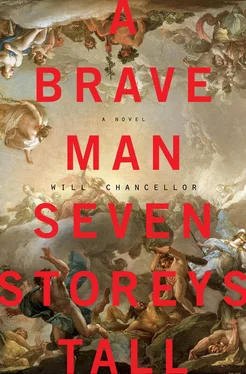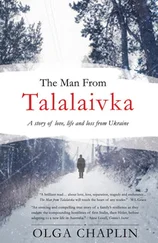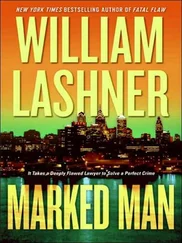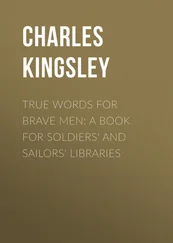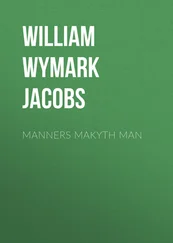The paracord in the lid of his backpack was designed for this very situation. Burr unspooled it all, knotted it to the handle of his pack, and paid out rope, inching it down one rope burn at a time. Halfway down it snagged on rock. He tried to free the cord, but almost lost his footing. Until now, the descent had seemed reversible. He would have to let it drop. Burr dropped the pack and realized he would have to follow it down the wet rock.
He didn’t hear anything crack, but it was stupid not to house the canister stove and, more importantly, the canisters of fuel. The whole pack could have exploded. Burr had seen enough of that sort of thing.
He looked over the edge he was about to descend without ropes. Does one face forward or backward when climbing down a rock? How foolish to have wasted his lifeline lowering a bag he could have easily carried, or dropped.
He looked down again and tried to plan a route.
It was no use. The rocks that looked stable obscured the rocks behind them. He dropped to his knees, looked around at the melting snowcap, the stretching greens of twilight, the slick black rocks, and thought, if one had to, this would be an acceptable place to die. But it would be a legendary place to not die.
He rolled onto his stomach and tapped his feet for the first rocks. After deep breaths, then quick breaths, he transferred his weight to his legs. He traded his grip on the ledge for a grip on the rock and was thus attached at four points. His short-lived rule for Owen on playground ladders was three points of contact at all times. Had he made that up? There had to be an underlying truth there. It was canonical today, because that was the first and only thing he knew about climbing: three points of contact at all times.
He found a ledge for his left foot. Four points of contact with the rock face. Now he could free his right leg. As soon as he transferred his weight to his left foot, the foothold crumbled away. A divot of moss dropped to the black rocks below. Burr quickly kicked for a new foothold and realized that he would have to test each purchase before abandoning his holds. This entire rock face was covered in moss from ledge to slick slope before the stream. It was impossible to tell what was an untouched clump of moss and what was a millimeter skin over a solid grip of rock.
Shaking with the strain of every grip, Burr picked his way down until he was faced with a completely smooth rock wall. He was out of footholds. In the past half hour he had descended about fifteen feet and was still another ten, at least, from the streambed. He didn’t have the energy to climb back up. Spidering along the side was beyond his level of competence, and besides, the smooth black U extended the length of the wall. He would have to slide and hope that he was able to slow himself enough to avoid the jagged rocks in the streambed. He assessed the situation. Rolling an ankle would be a fatal injury in a place like this. He could see fifty miles, and there was no one. The moss suggested that no one had climbed this rock for quite some time, if ever. If he rolled an ankle and couldn’t hike out, it would be decades before someone found his body. He breathed deeply. His hands were shaking from stress and from strain. If he didn’t do something, his muscles were going to give out, or his heart was. He let go.
His toes skidded down the smooth black wall, his fingers clawing for anything, his nose never more than an inch from the rock while his forearms protected his head, down to the bottom of the slope and stopped, less than a foot from a crippling black rock.
It took him a minute to realize he was stable. He hyperventilated. He was light-headed. That could have cost him his life, and it was over in a blip. It was past. Shaking, Burr looked out at the flooded valley below. Hundreds of sheep on the grassy slope echoed the ice caps. The smoke over the fjord caught the long waves of twilight. What a place to survive. And what a story for his son.
Across the stream, cantilevered stone shaded the wet grass. Burr removed the scuffed trekking poles strapped to the side of the pack, hoisted his backpack, and picked his way over the three-foot stream from slippery rock to slippery rock, taking a series of delicate steps where a leap might have sufficed. He collapsed on the far side, his pack his pillow. Looking up at the weathered rock, he spotted a cave. He knew Owen would have done the same.
This was the second valley he had hiked into and the first cave he had seen. Burr climbed up the opposing rock until he could see the back of the empty cave, which was no more than a rock shelter.
Burr made a thankful camp next to the stream. His wrist alarm woke him at six the next morning. By seven he was eating trail mix, his boots were laced, and every stitch of gear was ready for his hunt for more caves.
By noon he was hiking into the third valley on the eastern side of Tröllaskagi. It cut deeper into the mountain and wound away from the lowland pastures. There were no outcroppings here, only glacier-worn scree. As he turned the final bend, he heard the report of a gunshot. He took off his electric blue jacket and pulled the grey rain cover over the red accents of his backpack. He doubled his pace over the rocks. After a half hour of scrambling, he turned to see where the shooter could be positioned. It sounded as if someone had fired at him from the next valley; the shot was certainly from a long way off. And there was only one. He scanned the heights.
The only anomaly in the uniformly grey talus was a small black mouth in the mountain at the end of this valley. He hiked another hundred yards to get a different angle and saw that the mouth of the cave was much larger, but camouflaged by a blue tarp weighed down with gravel and moss.
He stopped to think. There had been no follow-up shot. Only the one. There was nothing to hunt up here, so the shot must have been meant for him. It sounded too faint to have come from the camouflaged cave. The cave seemed no more than sixty yards away, but in Iceland he had no sense of perspective. He’d be exposed on rock the entire time. But the only way was up. He chanced it.
Burr scrambled up the scree and grabbed a rock when it got steeper. He took a big step and slid. He settled a few feet lower, hands gripping the slab that had just been under his feet. He ground in the toes of his boots an inch deeper, to the firmer rock beneath the gravel, and pulled himself back to the slab. He angled into the rock and listened for another shot.
His approach had been too direct. The rock threatened to crumble with every step and take him hundreds of feet down. To get up, he’d have to kick steps and take a switchback route. His trekking poles were more of a liability than an asset — whenever he put weight on the uphill pole, the rock slid down and threatened to sweep him away from the cave in an unfightable riptide. He telescoped down his aluminum poles and lashed them to his pack.
Inch by inch, kicking in his boots and testing each step, Burr angled up the hill, certain at this point that if the shooter was in range, he would have been hit by now, or at least heard a shot. He heard nothing but his breathing.
Every tenth step a slide.
After a half hour, he’d completed the forty-foot scramble to the surety of boulders. He sipped from the dromedary attached to his pack and looked down on the runnels of black rocks each of his slides had upturned.
Burr looked up again to the cave. There was no motion, no sound in the bunker. He pushed hard with his upper legs on the tested holds, certain that if he missed a grip and skidded back down, he wouldn’t have the energy to repeat the ascent.
The ledge was no more than a foot wide and at eye level. He reached high and caught the ground with elbows like axes. Gravel bits burrowed into his fleece and hands as he hauled up his stomach, then his hips, then tilted forward and dangled his feet in the air.
Читать дальше
